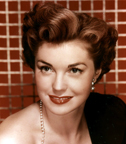Here are 10 things you should know about Dick Powell, born 115 years ago today. For our money, he executed one of the most impressive career reinventions in Hollywood history.
Tag: June Allyson
10 Things You Should Know About June Allyson
Here are 10 things you should know about June Allyson, born 104 years ago today. She made a career of playing girl-next-door girlfriends and wives.
10 Things You Should Know About Joan Blondell
Here are 10 things you should know about Joan Blondell, born 114 years ago today. She’s a favorite here at Cladrite Radio; if her name is in the credits, we’re watching.
Happy 110th Birthday, Joan Blondell!
The wonderful Joan Blondell was born into a vaudeville family 110 years ago today in New York City. A performer from early childhood, she provided a spark to just about any picture or program she appeared in. Here are 10 JB Did-You-Knows:
- Blondell toured with her family’s act, the Bouncing Blondells, until she was 17, at which point the family settled in Dallas, Texas.
- In Dallas, Blondell became a beauty contest contestant under the name Rosebud Blondell. She won the 1926 Miss Dallas pageant, was a finalist in an early version of the Miss Universe pageant in May of that year, and came in fourth in that year’s Miss America pageant in Atlantic City, New Jersey.
- Blondell relocated to NYC around 1927 to join a stock theatrical company, and in 1930, she appeared on Broadway opposite James Cagney in a play called Penny Arcade (Cagney would soon make his film debut in the film version of the play, Sinners’ Holiday; Blondell was in that picture, too, but she already had a small handful of films to her credit at that point). Both Cagney and Blondell repeated their Broadway roles in the film version at the insistence of Al Jolson, who’d seen the play on Broadway and purchased the film rights, though the play had closed after just three weeks.
- Blondell and Cagney made six pictures together at Warner Brothers—more than any other actress.
- Blondell was a WAMPAS Baby Star in 1930.
- Blondell was married three times—to cinematographer George Barnes for just under three years, to actor and crooner Dick Powell for just under eight years and to theatrical impresario Michael Todd for just under three years. She had a son with Barnes and a daughter with Powell.
- When she signed with Warner Brothers, Jack Warner urged her to change her name—he thought Inez Holmes had a nice ring to it—but Blondell refused.
- In 1972, Blondell published a novel, Center Door Fancy, that was said to be something of a roman à clef, with characters based on former husband Dick Powell and his third wife, June Allyson, with whom he had an affair while married to Blondell.
- Blondell was nominated once for an Oscar, in the Best Supporting Actress category for her work in The Blue Veil (1951).
- In a career that lasted a half-century (if you count vaudeville, her career lasted 75 years), Blondell totaled more than 150 combined credits in pictures and on television. She worked until the very end, with her two final films released after her death of leukemia in 1979.
Happy birthday, Joan Blondell, wherever you may be!

Esther Williams: A Life Aquatic
 We were sorry to learn that the always lovely Esther Williams has backstroked off to the deep end of the pool at the age of 91.
We were sorry to learn that the always lovely Esther Williams has backstroked off to the deep end of the pool at the age of 91.
So we thought it an apt time to share (once again) with the Cladrite community an interview we did with the divine Ms. Williams some years ago on the occasion of the publication of her memoir, The Million Dollar Mermaid: An Autobiography.
Enjoy! But wait at least an hour after eating before beginning this Q&A.
An Interview with Esther Williams
In the 1940s and ’50s, Esther Williams was one of the brightest stars in MGM’s galaxy. Her movies, with their memorable Busby Berkeley-choreographed aquatic extravaganzas, remain hugely popular today in revival houses and on cable television.
And now, with the publication of her autobiography, Williams shares candid tales of her life as Hollywood’s “Million Dollar Mermaid.” We chatted with Ms. Williams about a wide range of topics, from her husband Fernando Lamas‘s sometimes philandering ways to cross-dressing in Hollywood. It was a conversation as lively and open as her book, The Million Dollar Mermaid: An Autobiography.
As we read your book, it struck us that you’ve have had a life filled with extreme highs and lows. There have been so many wonderful chapters in your life, but so many sad and tragic events as well.
It’s the idea that you’re smiling underwater—doing the impossible!—and then going home to a life that’s unraveling around you…I was struck with it, too. You know, writing your autobiography is therapy. You get in tune with a lot of things you thought you’d forgotten.
Fernando [Lamas] had asked me years ago not to be in the movies or television or do interviews anymore; as I say in my book, he asked, “Can you stop being Esther Williams?” And I said, “Well, that’s an interesting idea; I’ve been her for a lot of years. Let’s see how I do without her.”
And when Fernando died in 1982, the thing I noticed about the death of a life partner, especially one as difficult as Fernando was—when they go, you’re out of a job! The first person that called me after he died was Shirley Maclaine, who is my friend, and she said, “Well, Esther, you can finally get out of the house.” And I thought, Oh, Shirley, you tell it like it is. I’m so very fond of her.
And then Barbara Walters called. And I said, “Oh, Barbara, I haven’t been photographed in 20 years!” The one thing that Katharine Hepburn said that really made sense to me is that good thing about the talk shows is that people get to watch you rot. And I said, “I’ve been rotting in private!” And she said, “I’ve seen you at parties and you don’t look like you’re rotting to me. I want you to come and do one of my specials.” I said, “I’m not going to look good next to Jane Fonda or Sally Field.” And she said, “I won’t put you next to Jane Fonda and Sally Field; I’ll put you in the middle segment—we’ll put Mr. T before you and Howard Cosell after you, two of the ugliest men in the world.” And I said, “Oh, then I’ll do the show—of course!” [laughs]
Early in the book you detail a clinical experience with LSD. Later, you reveal that you were the victim of a rape at the hands of a family friend when you were a young woman, that your older brother died a tragic death when he was just in his teens. Was the book a form of catharsis for you?
You know, we seem to acquire, as we age and deal with various diminished capacities, an ability to articulate our feelings. To say, “No, no, you don’t understand. It wasn’t that way; it was this way.” And what happened to me is that, when I would go through the problems of day-to-day living, it was always wonderful to go to the studio and dive into that wonderful water. The water was very healing for me, and it remains so even today. I’m in my 70s. I had a knee replaced not so long ago and was going through physical therapy, and it hurt, you know? They’ve got to bring the muscles along, and it hurts.
So I said to Mark, my physical therapist—he came to my house to work with me, and he didn’t know how to swim—I said, “You’re $60 an hour, Mark. And you hurt. I don’t want to be hurting anymore; I’m going to get in the pool. And I tell you what we’ll do—we’ll call the $60 a push, because that’s what I’ll charge you for your swimming lesson. And I got him swimming, and he loved it.
What an opportunity for him, to receive a swimming lesson from Esther Williams! That’s a rare opportunity.
I thought it was worth the $60! Candy Bergen rang my doorbell one day and said, “I want [her daughter] Chloe to learn to swim.” And I said, “If you wanted her to learn to play piano, would you ring Artur Rubenstein‘s door?” And she said, “I don’t care if she plays piano, but she’s got to learn to swim.” And I said, “Yes, that’s true. Because that can save her life. Piano won’t ever save her life.”
Are you pleased—or perhaps surprised—by the rise of women’s athletics? Would you ever have imagined the sort of attention that’s been lavished on the U.S. women’s soccer team or the Olympic basketball players and gymnasts?
And synchronized swimming! It’s an Olympic sport now. Yes, it’s very exciting.
Read More »
